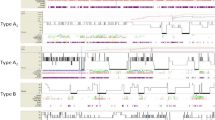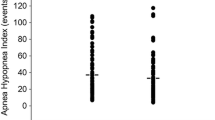Abstract
Purpose
Treatment-emergent central sleep apnea (TE-CSA) is defined as the emergence or persistence of central respiratory events during the initiation of positive airway pressure (PAP) without a back-up rate in obstructive sleep apnea (OSA) patients and after significant resolution of obstructive events. Previous studies have estimated a prevalence from 0.56 to 20.3%. The aim of this study was to establish the prevalence of TE-CSA in a Greek adult population.
Methods
One thousand fifty nine patients with newly diagnosed OSA, who were referred to the Sleep Disorders Center of Evangelismos Hospital of Athens over an 18-month period, were included in this study. A split-night polysomnography (PSG), or two formal overnight PSGs (diagnostic and continuous PAP (CPAP) titration study), were performed.
Results
Patients with OSA were divided in two groups; the first group included 277 patients, who underwent two separate studies (diagnostic and CPAP titration study), and the second group 782 patients, who underwent split-night studies. The prevalence of TE-CSA in the first group was 2.53% (7 patients), and in the second group was 5.63% (44 patients).
Conclusions
The prevalence of TE-CSA in Greece was lower compared to most previous reported studies. The significant variation in the prevalence of TE-CSA between different centers throughout the world is mainly associated with the used diagnostic criteria as well as methodological and technical aspects.


Similar content being viewed by others
References
Marrone O, Stallone A, Salvaggio A, Milone F, Bellia V, Bonsignore G (1991) Occurrence of breathing disorders during CPAP administration in obstructive sleep apnea syndrome. Eur Respir J 4(6):660–666
Sullivan CE, Berthon-Jones M, Issa FG, Eves (1981) Reversal of obstructive sleep apnoea by continuous positive airway pressure applied through the nares. Lancet 317(8225):862–865. https://doi.org/10.1016/S0140-6736(81)92140-1
Gilmartin G, Daly R, Thomas R (2005) Recognition and management of complex sleep-disordered breathing. Curr Opin Pulm Med 11(6):485–493. https://doi.org/10.1097/01.mcp.0000183061.98665.b0
Morgenthaler TI, Kagramanov V, Hanak V, Decker PA (2006) Complex sleep apnea syndrome: is it a unique clinical syndrome? Sleep 29(9):1203–1209. https://doi.org/10.1093/sleep/29.9.1203
American Academy of Sleep Medicine (2014) International classification of sleep disorders, 3rd edn. Darien, IL
Westhoff M, Arzt M, Lietterst P (2012) Prevalence and treatment of central sleep apnoea emerging after initiation of continuous positive airway pressure in patients with obstructive sleep apnoea without evidence of heart failure. Sleep Breath 16(1):71–78. https://doi.org/10.1007/s11325-011-0486-0
Verbraecken J (2013) Complex sleep apnoea syndrome. Breathe 9(5):372–380. https://doi.org/10.1183/20734735.042412
Pusalavidyasagar SS, Olson EJ, Gay PC, Morgenthaler TI (2006) Treatment of complex sleep apnea syndrome: a retrospective comparative review. Sleep Med 7(6):474–479. https://doi.org/10.1016/j.sleep.2006.04.005
Endo Y, Suzuki M, Inoue Y, Sato M, Namba K, Hasegawa M, Matsuura M (2008) Prevalence of complex sleep apnea among Japanese patients with sleep apnea syndrome. Tohoku J Exp Med 215(4):349–354. https://doi.org/10.1620/tjem.215.349
Cassel W, Canisius S, Becker HF, Leistner S, Ploch T, Jerrentrup A, Vogelmeier C, Koehler U, Heitmann J (2011) A prospective polysomnographic study on the evolution of complex sleep apnoea. Eur Respir J 38(2):329–337. https://doi.org/10.1183/09031936.00162009
Berry RB, Brooks R, Gamaldo CE, et al For the American Academy of Sleep Medicine (2015) The AASM manual for the scoring of sleep and associated events: rules, terminology and technical specifications, version 2.2. Darien, Illinois: American Academy of Sleep Medicine
Lehman S, Antic NA, Thompson C, Catcheside PG, Mercer J, McEvoy RD (2007) Central sleep apnea on commencement of continuous positive airway pressure in patients with a primary diagnosis of obstructive sleep apnea-hypopnea. J Clin Sleep Med 3(5):462–466
Bitter T, Westerheide N, Hossain MS, Lehmann R, Prinz C, Kleemeyer A, Horstkotte D, Oldenburg O (2011) Complex sleep apnoea in congestive heart failure. Thorax 66(5):402–407. https://doi.org/10.1136/thx.2010.146522
Bazurto Zapata MA, Martinez-Guzman W, Vargas-Ramirez L, Herrera K, Gonzalez-Garcia M (2015) Prevalence of central sleep apnea during continuous positive airway pressure (CPAP) titration in subjects with obstructive sleep apnea syndrome at an altitude of 2640 m. Sleep Med 16(3):343–346. https://doi.org/10.1016/j.sleep.2014.09.022
Dernaika T, Tawk M, Nazir S, Younis W, Kinasewitz GT (2007) The significance and outcome of continuous positive airway pressure-related central sleep apnea during split-night sleep studies. Chest 132(1):81–87. https://doi.org/10.1378/chest.06-2562
Javaheri S, Smith J, Chung E (2009) The prevalence and natural history of complex sleep apnea. J Clin Sleep Med 5(3):205–211
Yaegashi H, Fujimoto K, Abe H, Orii K, Eda S, Kubo K (2009) Characteristics of Japanese patients with complex sleep apnea syndrome: a retrospective comparison with obstructive sleep apnea syndrome. Intern Med 48(6):427–432. https://doi.org/10.2169/internalmedicine.48.1459
Morgenthaler TI, Aurora RN, Brown T, Zak R, Alessi C, Boehlecke B, Chesson AL, Friedman L, Kapur V, Maganti R, Owens J, Pancer J, Swick TJ, Standards of Practice Committee of the AASM (2008) Practice parameters for the use of autotitrating continuous positive airway pressure devices for titrating pressures and treating adult patients with obstructive sleep apnea syndrome: an update for 2007. Sleep 31(1):141–147. https://doi.org/10.1093/sleep/31.1.141
Oksenberg A, Arons E, Snir D, Radwan H, Soroker N (2002) Cheyne-Stokes respiration during sleep: a possible effect of body position. Med Sci Monit 8(7):CS61–CS65
Sahlin C, Svanborg E, Stenlund H, Franklin KA (2005) Cheyne-Stokes respiration and supine dependency. Eur Respir J 25(5):829–833. https://doi.org/10.1183/09031936.05.00107904
Szollosi I, Roebuck T, Thompson B, Naughton MT (2006) Lateral sleeping position reduces severity of central sleep apnea/Cheyne-Stokes respiration. Sleep 29(8):1045–1051. https://doi.org/10.1093/sleep/29.8.1045
Joho S, Oda Y, Hirai T, Inoue H (2010) Impact of sleeping position on central sleep apnea/Cheyne-Stokes respiration in patients with heart failure. Sleep 11(2):143–148. https://doi.org/10.1016/j.sleep.2009.05.014
Allam JS, Olson EJ, Gay PC, Morgenthaler TI (2007) Efficacy of adaptive servoventilation in treatment of complex and central sleep apnea syndromes. Chest 132(6):1839–1846. https://doi.org/10.1378/chest.07-1715
Nigam G, Pathak C, Riaz M (2016) A systematic review on prevalence and risk factors associated with treatment-emergent central sleep apnea. Ann Thorac Med 11(3):202–210. https://doi.org/10.4103/1817-1737.185761
Kuzniar T, Pusalavidyasagar S, Gay P, Morgenthaler T (2008) Natural course of complex sleep apnea-a retrospective study. Sleep Breath 12(2):135–139. https://doi.org/10.1007/s11325-007-0140-z
Liu D, Armitstead J, Benjafield A, Shao S, Malhotra A, Cistulli PA, Pepin JL, Woehrle H (2017) Trajectories of emergent central sleep apnea during CPAP therapy. Chest 152(4):751–760. https://doi.org/10.1016/j.chest.2017.06.010
Author information
Authors and Affiliations
Corresponding author
Ethics declarations
This study has been approved by our Institutional Research Ethics Committee and it also complies to the Declaration of Helsinski.
Conflict of interest
All authors declare that they have no conflict of interest.
Rights and permissions
About this article
Cite this article
Baou, K., Mermigkis, C., Minaritzoglou, A. et al. Complex sleep apnea after full-night and split-night polysomnography: the Greek experience. Sleep Breath 22, 713–719 (2018). https://doi.org/10.1007/s11325-017-1601-7
Received:
Revised:
Accepted:
Published:
Issue Date:
DOI: https://doi.org/10.1007/s11325-017-1601-7




